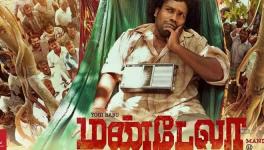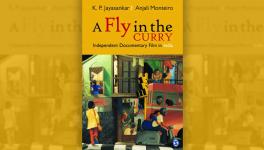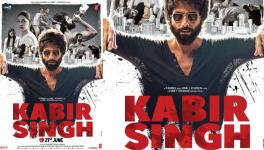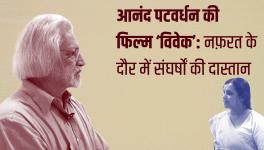Film as a Medium for Social Change
Newsclick speaks to Madhusree Dutta, film maker and one of the founders of Majlis, a centre for rights discourse and inter-disciplinary art initiatives in Mumbai. It is necessary for a cultural activist to thoroughly understand the medium in which one is working. Madhusree emphasises on having interfaces between technology and culture, between politics and cultural practices, between various disciplines, etc. She underscores that in today's world knowing technology is important as culture too has become technology-intensive.
Transcript:
Prabir Purkayastha (PP): Hello and welcome to Newsclick. Today, we have with us Madhusree Dutta, Film maker and one of the Founders of Majlis, devoted to using film as medium for social change. Does it describe us what Majlis is supposed to do?
Madhusree Dutta (MD): Well, it depends on what we call social causes and what we call films. We make certain kinds of films. And I would like to put in one from the very beginning that we make very entertaining films. At least, I believe they are entertaining. So it's not that social causes means that some God's voice tells us few truth that that we don't know and establishes few facts that should be known by truth. That's what is understood as films with social causes.
PP: What you mean is social cause does not mean it has to be it be boring and tedious. It that what you mean?
MD: It should not be boring and tedious and it should not also be pedagogical. We make a mistake... we think anything pedagogical... it's like education. We think politics is all about educating others. At least, cultural politics is all about educating others. I think that... we make a big mistake when we work in the social sector and we think we are cultural activists. So activists become more important than cultural. So then the activists agenda only get translated only either on screen or in writing or in music. But culture is not important. And that is where we loose out on audience.
PP: How would you define then what you think a cultural activist should be who is not in this mode?
MD: You know, first of all cultural activist should be... should know cultural action very well. That means cultural scene should be the primary sector and activism should be the secondary sector. It's like translation, which language to which language. So you need to know the language you are translating from. If you are translating from English to Bengali then you should know English very well. Bengali you can learn when you are translating. Similarly, if you are cultural activist you should know what is cultural action. What is the action within the cultural scene. Because cultural scene is parallel to political action. Cultural action should be treated as parallel, equal, as white, as deep as political action. In that, you need to know cultural action very well and then think that how politics can be interwoven, interfaces within that. So, that is why when you say films with social cause, I want to say films should be prioritised and then social cause. I not only make films, I think I am a cultural activist. So I have an interdisciplinary interest. I mean I also work with visual artist and texts; we make books; we work with architects because more and more urbanisation is happening in the country, in the world. So architecture is not only any more designing buildings. Architecture is becoming land use, space use, rights to the space. So understanding architectural designing is also very important. So these are all my interest and we work with all these sectors in Majlis.
PP: So essentially one part of the work which you think is very important is that if you want to be a good cultural activist, you really must understand the medium in which you are working very well. If you don't do that then rest of it doesn't follow.
MD: Yeah, definitely. It is not only … there are many things about knowing the sector. Like, you will be interested in this. You need to know technology very well because today culture is nothing if you don't understand the technology. It is technology-intensive, it is technology-based, it is technology-obsessed. Production, distribution, outreach... everything now today depends on technology.
PP: But Madhusri, this all has been true. Great artists have also been pioneers in technology. Though people may not believe it. I mean Leonardo Da Vinci is only one example. But there are many others. In fact, a lot of the advances in what was thought to be art really came out of their understanding how the human eye perceives pictures, perspective making up of the picture into different points. The pointillism kind of things. It's really about the eye. So this has always been there. But people periodically tend to forget.
MD: And they think... somehow, there is this thing that technology is too hardcore you know, whereas culture should be little soft, it's all about emotion, and inner code and something like that. And technology is too hand down, it is too secular, it is too... make with your hands and art you do not make with your hands, which is not true. You make art with your hands. So I am also very interested, Prabir, which should be your and mine common interest is that, labour in art. If we look at art as production, social production, social mode of production then how labour function in that. If you remember you came for my exhibition on “cinema city”, that was to actually look at cinema which India is known for it's phenomenal cinema mindedness. Some people think it is curse, because of popular cinema everything else is killed. Somebody thinks that well that's our post-colonial identity. I don't want to get into that debate. But I happen to work and live in a city which produces the largest number of cinema in the world, as they say. Well, I mean it is not the question of number but it is a very cinema-minded city because every third person wants to be in the film industry. They can become one or not... and aspiration has a very important role to play in who will become labour, unorganised labour. I mean, who aspires to be a part of an industry as undefined as film industry also becomes a cheap labour. Because I aspire, so I will agree to do anything you want me to do at any cost. So I become the cheap labour, I become the unorganised labour and that is how the industry works. Because it does not have an industry structure. And we talk so much about Hindi Cinema whether it is good, bad, what is the social implication of it. There are so many film studies... thing, but we are not talking about that how it is managing it's labour force, how it is producing. After all, it is a production. It needs technology, it needs human power, it needs talent, skill, planning, finance. So, it is a manufacturing phenomenon, you know.
PP: Mahdusri, that's a very interesting point that you are bringing up because worldwide, factory as a medium of production of films, really the studio system has broken up, and you are seeing now a far more decentralised work force which comes together, and it is all unorganised labour the way you defining it, comes together, makes a film and goes away. So that whole concept of stability or work, etc. all of that is gone.
MD: So it is more of a sweatshop culture. What's happening is they are not even coming together. That's what I am saying is really like the post-industrial labour management that is happening in manufacturing industry. That somebody makes moustache, he has no idea for whom which film is making moustache. He is sitting in sweatshop and going on making moustache. May be ten in a day, or may be hundred a day. The moustaches are going to different films. Somebody is just sewing buttons. Somebody is just making a leather jacket, or naybe the sleeve of the leather jacket or the sequin of the leather jacket. So these are the sweatshops across the city. So there is an invisible network from where the leather jacket is coming from where, say, the dog is coming, from where the horses are coming, from where the costume is coming, from where the property is coming which is coming together and the people who are at this end of the the sweatshop end have no idea what the last product is. They will never see the last product. When they go to see the film as an audience they will not even recognise that they have a role in that. That their labour has gone into that.
PP: So this is what you did to bring this out in the exhibition that you had organised? Is that purpose of the exhibition to bring all this out?
MD: Yeah, because I thought that now films... because this year is supposed to be hundred years of Indian Cinema, so any cultural any cultural production which has produced such a phenomenal number of films that can today celebrate the centenary year... So what is the production module it has evolved. What is the system? And I am surprised that neither at the industry end of it nor at the cultural end of it, anybody really thought about how the labour is functioning. We talked about heroes, we talked about heroines, we talked about how the junior artists are exploited. We talked about gender exploitation, we talked about foreigners coming and taking over Indians' jobs as dancers... various things. But these are all are related to visibility because in cinema whoever you can see whether they are exploited or if they are vandalized we can see that and we talk about it. Stars are good or bad, junior artists are paid well or not but we don't talk about that how they are manufactured.
PP: Issue of looking at the film as an industry how the various aspects of labours that goes into it. This is something that you are currently interested in. Also, you were also very interested in the architecture of the city as it changes with the changes in the way films are shown, manufactured, distributed and so on. So you tell us what has happened to the films halls, the talkies, all that was there. What has happened to it now?
MD: You know Prabir, it is... like I am interested in the city because I think that it is only a sample. This will be replicated in various degrees and various patterns in various other places because aggressive urbanization is the call of the day whether you like it or not. So better look at in the prime urban land that we have, and in this case it is Bombay, how it happens. So when I was getting interested in that, I realised that this is massive participation. Hundreds of people must participate in this because we are trying to write history of today. We are trying to archive today, contemporary and that unless people participate... you like a historian or like an excavator you cannot go because it is not past. You are doing it today. Because urbanisation is happening today. At the same time, urbanisation makes it such that today is already yesterday. As before you started this, you could hear me speaking to somebody. There is a cinema called Bharat Mata. Bharat Mata is a very interesting story in Bombay. Bharat Mata started in 1932. It was called Laxmi theatre. Started by the mill owners because workers were running away to home and not coming back. So they thought there has to be something which is not there in the village and what was that? A cinema hall. So 24 hours, depending on the shift I mean that is shift gets over at 6 o'clock in the morning 7 o'clock is one show, 11 o'clock is one show. If shift gets over at 2 o'clock, 3 o'clock will be another show. Another shift gets over at 8 o'clock in the evening, so 9 o'clock will be another show. So like that depending on the shift, I mean the films were shown for nominal amount, sometimes free. Just so that workers stay back. This is one of the earliest cinemas, there are many others. In 1942, during the Quit India Movement, they all became nationalists because as you know, nationalist movement was hugely supported by this textile owners. So they change the names to Bharat Mata, Hind Mata and Jai Hind. These are the three theatres. So Laxmi theatre became Bharat Mata, Venus became Jai Hind, so that was the call of the time. Many theatres have gone but Bharat Mata somehow stayed back. Bharat Mata still shows films at 12 Rupees per ticket. They are the only theatre which still primarily shows Marathi theatre though Marathi cinema does not produce that many films. So the only way Bharat Mata can be saved by using the Marathi sentiments because the real estate is really breathing down the mill land and it is at the heart of the mill land. There is no reason why it still did not get demolished and the reason I suspect is that sometimes strategically we could whip up the Marathi sentiment. That if this goes, this is the last bastion of Marathi language cinema, so let's protect it. Now, three years back we did a study of Bharat Mata. We took some photos. Now the study has come to an end. We are trying to publish a book and one image of Bharat Mata is there. Day before yesterday my designer said that you know this picture is very low raise it is just from outside the theatre. We can definitely go and take another photo. I said sure and we just got call that Bharat Mata got completely renovated and that image that we want is not possible any more. So urban history is like that. It is contemporary but also at the same time past tense. Before you could capture it, it has already become past. So it is very difficult time, it's a very difficult proposition, very difficult task... how do you catch urbanity in terms of land, in terms of tactility. Not in terms of emotion, not about displacement. Not these, but actually how can you touch it. So I thought that cinema halls can be one such thing. We have roads that are known by cinema halls. People's memory of “oh! I went from this place to that place by Ghoda Gaadi to see that film”. This kind of memory everybody shares. How did you feel when you saw movie in Alfred cinema? People came out with fantastic narratives. So that becomes collection because that became actually knowing the city navigating the city through cinema. So you get older women's memory of what was their relation to the city space because how much they travel, how much they could not travel. Why is “Janana” show at three. I mean obviously I am interested in gender also. This 3 o'clock shows this “Janana” shows that used to happen why they came up? What was the commercial reason. Obviously, women made that much audience that special shows that women were important. At which point it became less important and which was taken out. So this is the study of the city but through memory or popular culture.
PP: What is your next project and what is your next book? Are you doing any... something more than what you have already done in one book that you have produced this fantastic exhibition which has gone around the country?
MD: Actually, the first book which was called “dates.sites”, it was a timeline. There also we wanted and timeline is generally when Akbar became a king and we all dreaded those studies where we have to remember which year Akbar became a king.
PP: And when battles took place.
MD: Yeah. I thought that there has to be some fun. So what we did we actually remember in the exhibition, there was a game that is bioscope. If you see through a bioscope, and what you see inside is many many small snippets when did Bal Thackeray launch Shiv Sena? What was the first film screened in Bombay land... Bombay soil? Things like that. They are all loose. So you actually activate a mechanism by pressing a button through which many many snippets of information will come your way and then you decide the order. How do you want it? So whether Alam Ara the first talkie shown in India and Bal Thackery taking oath at Dussera Rally in Shivaji Park together make a history, or doesn't make a history? Or whether they belong to two different history. I live it on my audience that. Then may be 1960 Shiv Sena starting may be an interesting you may remember. If you don't remember but it's okay. But Alam Ara is also first and Shiv Sena is also first. Is there a connection or not? Is there the Bombay lies? That then we anthologise in a book. Where the small small informations... the fun is in adding them together. You participate in arranging. Then you participate in what you think should be history and not where the battle took place. So that was actually in a way ushering my audience into this concept of participating in making history. Also, history is important only because we are looking at it from the contemporary position. So that was the first book. It was in a way also a collusion with way of history teaching takes place. Whether there can be a popular cultural avtar of history teaching. Whether it can be fun. It can be participatory and it can be also kept open. Not kept open to decide whether Ram was born in Ayodhya or not. But to keep open that how will you make the chronology of Babri Masjid, you decide. Does it start in 1948? Does it start in Tetrayug? Or does it start in 1992. That kind of investment I am making in history. So the second book which should be out in December is actually an anthology of the whole project. So where the architectural maps, the films, the artworks that we produced and the text all come together and is simply called “Project Cinema City”. But there also we are trying to say memories, labour, unorganised labour, popular culture, this kind of space politics that we talked about... whether they can all come together and talked to each other, rather than this is women's study, women's memory and this is labour study of unorganised labour and this is cultural study of popular cultural phenomenon. I think this kind of disciplinary divisions have not been proved very effective. We need to have effort of small or large scale. We need to have interfaces between technology and art, between politics and cultural practice, between disciplines, between sociology, architecture and music and dance. I think in whatever scale we should try to have interfaces. If you don't have interfaces in our intellectual thinking, we will not have interfaces in social life.
PP: Madhusree, it's been a pleasure to talk to you and we eagerly await your book which will make the whole project out including the wonderful old man who spent his life in reusing various products, waste products of the films. I remember it will always stay in the memory. I think those kinds of images are really interesting as well as bring out the larger picture. Thank you very much and hope when your book is released we'll again get a chance to talk to you again.
Get the latest reports & analysis with people's perspective on Protests, movements & deep analytical videos, discussions of the current affairs in your Telegram app. Subscribe to NewsClick's Telegram channel & get Real-Time updates on stories, as they get published on our website.
























